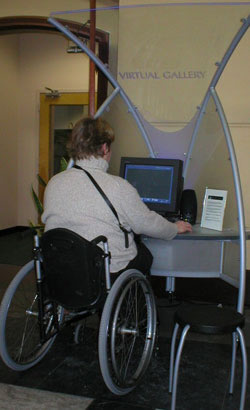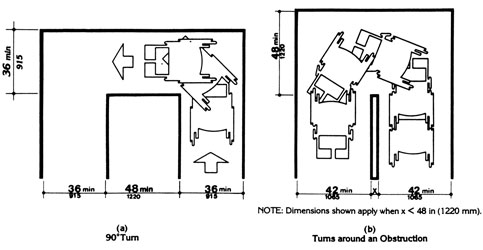Accessible Routes Throughout the Museum
-
If directional signs to accessible building features are mounted on movable pedestals, they must be monitored to ensure they are in place and continue to provide correct directions, including information about the accessible route(s) for special events.
-
If accessible routes through the building are temporarily blocked when exhibitions are installed, de-installed, maintained, or roped off for special events, alternate routes must be created with proper directional signage at key route decision points. Movable exhibition seating or furniture for exhibit interactives must be monitored so that they do not block accessible routes, present tripping hazards throughout the exhibition, or prevent access to exhibit cases, interactives, or media presentations.
-
Some people who are blind or have low vision use canes to detect barriers that jut into the path of travel, whether along the accessible route or any other circulation path. Objects, signage, light fixtures, and exhibitry (or tree branches and shrubs along outdoor paths) can present bumping hazards if they are between 27 and 80 inches above the ground. Care must be taken either to keep protruding objects or those with low head clearance out of the path of travel or to install cane-detectable barriers below them.
-
Stanchions that define ticket lines or serve as exhibit barriers must also be cane detectable for people who are blind or have low vision.
-
If people must travel between stanchions or between a wall and a stanchion, passage must be maintained at a minimum of 36 inches wide, measured from inside edge to inside edge of the stanchion bases or floor moldings, except at doors where the width may narrow to 32 inches for a maximum distance of two feet. If a person must make a turn in the route, the minimum clear passage width is shown in Figures (a) and (b).
-
Elevators serving public spaces must remain operable. If they are out of service for repair or maintenance and provide the only accessible route to an area, temporary alternate access to exhibitions and programs may be provided using photographic, video, or computer presentations.
-
If a museum uses a non-public elevator to provide people with disabilities access to public floors, clear signage must be maintained at key decision points to tell visitors where they need to go and what they need to do to use that elevator.



User Comments/Questions
Add Comment/Question